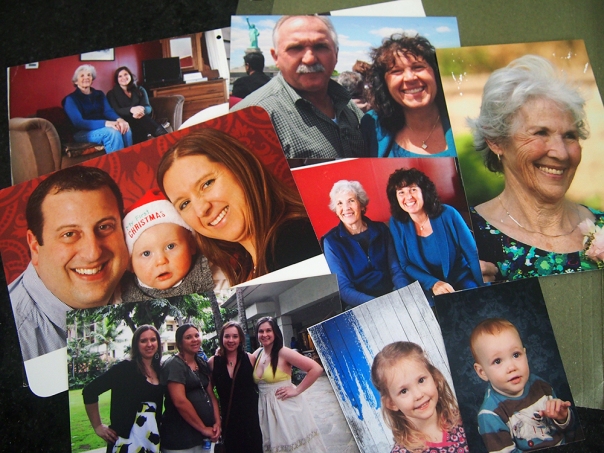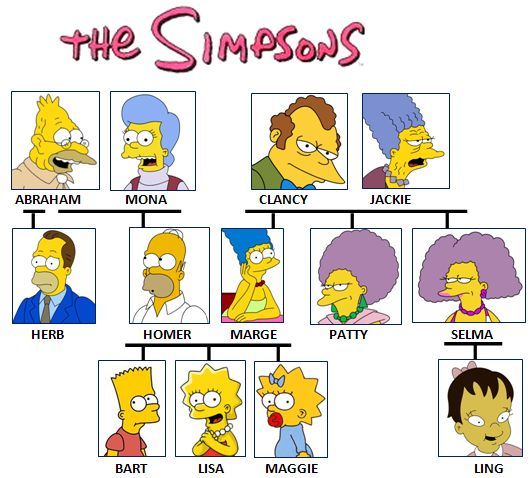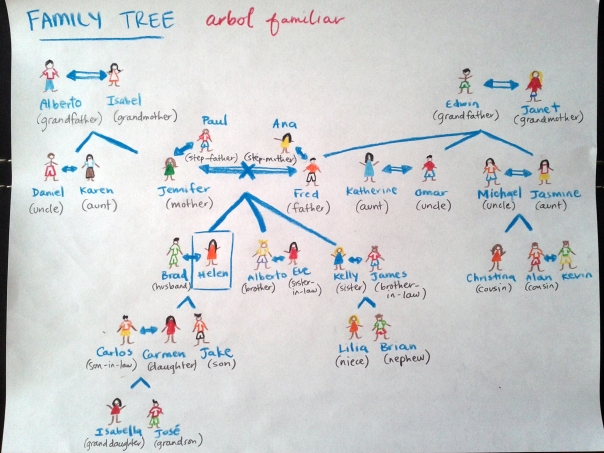This lesson focuses on speaking and listening. It can be used in beginner to intermediate adult community classes or high school conversation clubs. At the end of the lesson, students should be able to identify family members on a family tree, form simple sentences in the present tense, and use possessive adjectives correctly.
Time: 1–1.5 hours
Materials:
- family photos
- markers/ colored pencils
- paper
- white board
- board markers
- post-it notes or index cards to write jeopardy questions
Vocabulary / Key Phrases:
~Questions and Key Phrases
- Who is he/she? // ¿Quien es?
- He/She is ______. // Él/Ella es _____.
- What is his/her name? // ¿Cómo se llama?
- His/Her name is ____. // Se llama _____.
- How many ___ do you have? // ¿Cuántos ___ tienes?
- I have _#_ _(family members) . // Tengo _#_ ________.
~Verbs
- To Be (I am, You are, He/She is, We are, You are, They are) // Ser (Yo soy, Tú eres, Él/Ella/Usted es, Nosotros somos, Ellos/Ellas/Ustedes Son)
- To Have (I have, You have, He/She has, We have, You have, They have) // Tener (Yo tengo, Tú tienes, Él/Ella/Usted tiene, Nosotros tenemos, Ellos/Ellas/Ustedes tienen)
~Family member nouns
- grandparents // abuelos
- grandmother, grandfather // abuela, abuelo
- parents // padres
- mother (mom), father (dad) // madre (mamá), padre (papá)
- daughter, son // hija, hijo
- granddaughter, grandson // nieta, nieto
- siblings // hermanos
- sister, brother // hermana, hermano
- niece, nephew // sobrina, sobrino
- wife, husband // esposa, esposo
- girlfriend, boyfriend // novia, novio
- aunt, uncle // tía, tío
- cousin // prima, primo
- step-mother, step-father // madrastro, padrastro
- step-sister, step-brother // hermanastra, hermanastro
- mother-in-law, father-in-law // suegra, suegro
- sister-in-law, brother-in-law // cuñada, cuñado
~Possessive adjectives
- my // mi, mis
- your // tu, tus
- his/her/its // su, sus
- our // nuestr@, nuestr@s
- your (pl) // su, sus
- their // su, sus
Lesson:
- Converse with students as they enter the classroom. “How are you today? How was your weekend?” Phrases from last week, etc. Perhaps bring some food to share. (5 minutes)
- Tongue Twister: “My sister Sandra has short, black hair. My brother Brad has big, brown eyes.” (5 minutes)

- Show your own family photos: “I have three sisters. Their names are Jennifer, Christina, and Laura.” etc. (5 minutes)
- Ask the students questions to test their prior knowledge. For example: “How many siblings do you have?” (5 minutes)

- Write the vocabulary and verb conjugations on the board, with Spanish translations if necessary. Hand out a photocopy or ask the students to copy the material in their notebook. Say each word and ask the students to repeat.Use a family tree from a popular TV show or movie, and ask students practice questions. For example: “Who’s Lisa’s sister? Maggie is her sister.” (For beginning-level students teach half the words on the vocabulary list.) (15 minutes)

- Students make their own family tree or a fictional telenovela-like family tree, labeled with the vocabulary. (20 minutes)
- Students present their family trees in front of the class. Example: “This is Helen. Brad is her husband. Alberto is her brother. Etc.” (10 minutes)
- Jeopardy:The students will be divided into teams of 3 or 4, and they will answer questions from three categories: Vocabulary, Grammar, and Random. (15 minutes)
- “Goodbye! See you next week.” Clean up. (5 minutes)
